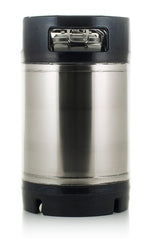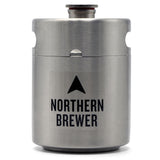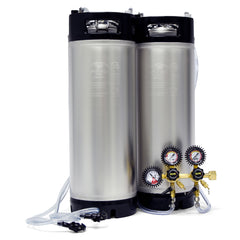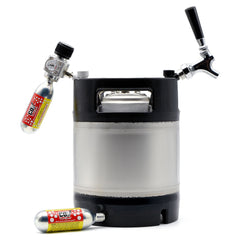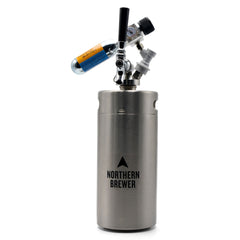Keg Buyer's Guide
Getting into kegging can be daunting at first, but once you get the hang of it, you'll be glad you started. Compared to bottling, you can more quickly carbonate your brew, there is less cleaning, and it takes much less time to manage. Let's cover the basics of what to consider when setting up a keg system.
Understanding Your Equipment
Refrigeration Type
There's a wide variety of refrigeration options to consider for kegging, and your choice will largely depend on the number and type of kegs you want to store or serve simultaneously. This could include corny kegs, commercial sixtels, mini kegs, and more.
You'll find various units suitable for keg storage, such as chest freezers, upright freezers, upright refrigerators, and dorm fridges. Any appliance designed for food storage may require an external temperature controller. Alternatively, you can even repurpose a standard used fridge to store a keg or two, as well as other packaged beverages, without the need for an external temperature controller.
Gas Supply
In most cases, your main choice will come down to deciding between 5-pound, 10-pound, or 20-pound CO2 tanks because they are the most commonly used options and are easily exchangeable for full tanks. What are the advantages and 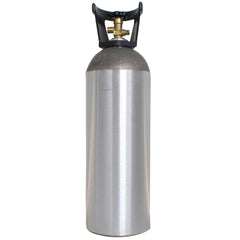 disadvantages of each? The 5-pound tank is more portable, making its a good choice if you plan to take your kegs outside of your home. The 10-pound tank offers more CO2, so you don't have to get it refilled or exchanged as often. On the other hand, 20-pound tanks are roughly the same size as a 5-gallon corny keg (or sixtel), but only cost about twice as much as the 5-pound tank to refill. 20-pound CO2 tanks are by far the most economical, but are not as easy to transport as the smaller tanks.
disadvantages of each? The 5-pound tank is more portable, making its a good choice if you plan to take your kegs outside of your home. The 10-pound tank offers more CO2, so you don't have to get it refilled or exchanged as often. On the other hand, 20-pound tanks are roughly the same size as a 5-gallon corny keg (or sixtel), but only cost about twice as much as the 5-pound tank to refill. 20-pound CO2 tanks are by far the most economical, but are not as easy to transport as the smaller tanks.
On average, you can anticipate carbonating and dispensing approximately 5 gallons of beer per pound of CO2, accounting for some waste. By doing some simple math, you'll find that a 20-pound tank will serve approximately 20, 5-gallon kegs before requiring a refill, although this may vary depending on factors such as the amount of purging and any potential leaks in your setup.
CO2 tanks purchased online are limited to empty 5-pound, 10-pound, or 20-pound tanks, and you'll need to get them filled locally.
Gas Distribution
Gas distribution starts with a pressure regulator that connects directly to the CO2 tank, as the tank pressure is around 800-1000 psi, which would be too much for the kegs and could lead to unwanted consequences. The purpose of the regulator is to reduce the pressure to a safe level, generally below 50 psi.
 Before you decide on a regulator and a downstream distribution system, it's worth contemplating how many distinct pressure levels you may require simultaneously. This Carbonation Chart takes out the guess work. Enthusiasts of various beer styles will understand that some benefit from lower carbonation (like Milds and ESBs), while others demand higher carbonation (such as Wheat Beers and Belgians). Most beers, like Pales and IPAs, fall somewhere in between. Your budget may determine how many different pressures you can work with, and it's not overly problematic to serve all your beers at a median pressure. The simplest and most economical solution is to install a single-pressure regulator on the tank, like the CO2PO Single Body Regulator. You can always expand into two or more pressure settings in the future by adding a manifold with built in regulators to split the main pressure line. Alternatively, you can make an initial decision to use at least two pressures by acquiring the CO2PO Double Body Regulator.
Before you decide on a regulator and a downstream distribution system, it's worth contemplating how many distinct pressure levels you may require simultaneously. This Carbonation Chart takes out the guess work. Enthusiasts of various beer styles will understand that some benefit from lower carbonation (like Milds and ESBs), while others demand higher carbonation (such as Wheat Beers and Belgians). Most beers, like Pales and IPAs, fall somewhere in between. Your budget may determine how many different pressures you can work with, and it's not overly problematic to serve all your beers at a median pressure. The simplest and most economical solution is to install a single-pressure regulator on the tank, like the CO2PO Single Body Regulator. You can always expand into two or more pressure settings in the future by adding a manifold with built in regulators to split the main pressure line. Alternatively, you can make an initial decision to use at least two pressures by acquiring the CO2PO Double Body Regulator.
Splitting
If you're beginning with a single pressure output, you can easily connect a hose directly to a single keg. However, if your intention is to supply gas to multiple kegs, there are a few options available.
 Firstly, you can route the hose into splitters like tees or crosses. This is the more budget-friendly approach, but it comes with a limitation – there's no way to shut off the gas supply to unused branches.
Firstly, you can route the hose into splitters like tees or crosses. This is the more budget-friendly approach, but it comes with a limitation – there's no way to shut off the gas supply to unused branches.
The alternative method involves running the single output line into a valved splitter manifold. While this option is a bit more expensive, it offers an advantage in that you can shut down the gas supply to any unused ports. This foresight can be beneficial for future expansions or changes in your setup.
The last option is the most expensive, but gives you the ability to shut off individual kegs as well as regulate the pressure individually between kegs, all from one gas line. For this, a secondary regulator, either 3-body or 4-body, is needed.
Tubing
Gas distribution tubing is commonly made from PVC, which can be either clear or of a solid color. The inner diameters of these tubes have varied between 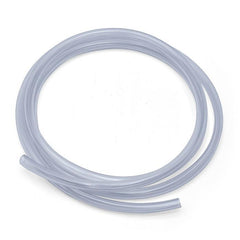 1/4 inch, 5/16 inch, and 3/8 inch. For our purposes, the tubing's performance doesn't change, so smaller diameter tubing is often preferred because it's easier to work with in a confined kegerator or keezer (keg freezer). If you are attaching this tubing to devices that already have fixed hose barb nipples, the barb size sometimes determines the tubing's inner diameter. It's worth noting that you can stretch smaller diameter PVC tubing over larger barbs by dipping it into near boiling water for about 30 seconds.
1/4 inch, 5/16 inch, and 3/8 inch. For our purposes, the tubing's performance doesn't change, so smaller diameter tubing is often preferred because it's easier to work with in a confined kegerator or keezer (keg freezer). If you are attaching this tubing to devices that already have fixed hose barb nipples, the barb size sometimes determines the tubing's inner diameter. It's worth noting that you can stretch smaller diameter PVC tubing over larger barbs by dipping it into near boiling water for about 30 seconds.
Kegs & Keg Systems

5 gallon "corny" kegs are the standard for homebrewers. You can keg homebrew, craft beer, cold brew coffee, soda, cider, mead, wine, and more. They have double rubber handles and a rubber bottom which makes transporting your keg much easier. Also, you can flip the keg and let it dry upside down as the handles act as a stand when its flipped over. They have ball-lock connections, plus a large removable lid with a pressure relief valve built in. If you want to keg, you'll likely want one or more of these 5 Gallon Ball Lock Corny Kegs. They are awesome!
Shop Now >
Mini Kegs
The 1.75 gallon mini keg lets you take your brew where every you go. Just like a 5 gallon keg, this 1.75 gallon mini keg has ball lock connections, double rubber handles, and a rubber bottom. It's a great option for small batches of homebrew, cocktail kegging, or using as a cleaning keg. As a cleaning keg, you'd fill this keg with PBW or Star San, connect it to gas and run the cleaner through dispensing lines and taps to keep them clean and fresh. It sure beats taking your taps and lines apart to clean separately.
Shop Now >
Just like a 5 gallon keg, this 2.5 gallon mini keg has ball lock connections, double rubber handles, and a rubber bottom. This keg is great for splitting 5 gallon batches and doing experiments with different types of yeast, lengths of aging, carbonation levels, and adjunct flavoring additions.
Shop Now >
Allegedly, some folks only want 3 gallons of beer, and would keg their entire batch with this keg. We haven't met these people, but 3 gallons transports much more easily than 5 gallons of brew. Just like a 5 gallon keg, this 3 gallon mini keg has ball lock connections, double rubber handles, and a rubber bottom. These kegs are great for splitting 6 gallon batches of brew, doing experiments with different types of yeast, lengths of aging, carbonation levels, and adjunct flavoring additions.
Shop Now >
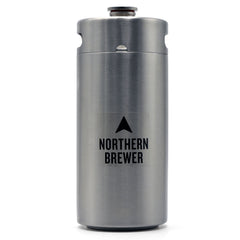 This keg is barely bigger than a milk jug and can slide straight onto a fridge shelf, pops in a cooler, or drops right into your trunk. This keg is great for tailgating, camping, picnicing, and partying. The 1 Gallon Mini Keg paired with the Mini Keg Dispensing Lid and Mini CO2 Regulator is the party-powering carbonation you need to have a good time, anytime and anywhere. Perfectly sized for small-batch brewers and a great addition to our one-gallon small-batch craft beer starter kits and one-gallon beer making recipe kits.
This keg is barely bigger than a milk jug and can slide straight onto a fridge shelf, pops in a cooler, or drops right into your trunk. This keg is great for tailgating, camping, picnicing, and partying. The 1 Gallon Mini Keg paired with the Mini Keg Dispensing Lid and Mini CO2 Regulator is the party-powering carbonation you need to have a good time, anytime and anywhere. Perfectly sized for small-batch brewers and a great addition to our one-gallon small-batch craft beer starter kits and one-gallon beer making recipe kits.Shop Now >
Even smaller, but no less mighty, the 1/2 gallon Mini Keg is great for splitting your larger batches into more manageable sizes for on the go convenient homebrew or experimentation! Try any of our flavor additions; crystallized fruit, silver cloud flavors, oak, or spices, and that new batch of Kolsch can easily become a honey Kolsch or a grapefruit Kolsch on a small scale before you experiment with an entire 5-gallon batch. Pair the 1/2 Gallon Mini Keg with the Mini Keg Dispensing Lid and Mini Co2 Regulator to have a good time anywhere you go.
Shop Now >
Cocktail Kegs
5 Gallon Bird Dog Cocktail Keg
If you are searching for a way to dispense cocktails with ease and consistency, cocktail kegging is your answer. The Bird Dog Cocktail Keg is identical to a regular 5 gallon corny keg, but it has a gas dip tube and a liquid dip tube that both reach the bottom of the keg. Regular kegs have short gas tubes that are supposed to stay above the liquid. The purpose of the second long tube is to mix your beverage each time you pour a drink, as CO2 bubbles will come out of the tube and mix the liquid.
Shop Now >
Keg Systems
Short on time, but want to start kegging. Pre-built Keg Systems are a great way to start kegging without having to source and build a system yourself. Get the perfect pour with the perfect system for your needs.
5 Gallon Keg with Regulator & Picnic Tap
This is hands down, the fastest, hassle-free way to get your very own taproom up and running ASAP. Start serving and sharing your brew within days of receiving your new system. All you need is a full CO2 cylinder and a place to chill your brew.
Shop Now >
Two 5 Gallon Kegs with Double Regulator & Picnic Taps
This is the first complete taproom in a box. You get two kegs and a double regulator so you can individually regulate each keg's pressure, allowing you to serve from one keg while force carbonating your second keg. Compact yet easily expandable, the Dual Keg System is the perfect place to start for any kegerator, fridge, or keezer build. All you need is a full CO2 cylinder to get the party started.
Shop Now >
A taproom at your fingertips. The small and mighty mini keg coupled with our Snap Tap beer faucet creates a dynamic duo that's sure to keep your beer flowing. It's powered by a mini CO2 regulator and 74g CO2 canister which packs a punch for its size. Small and portable, this mini keg has ball lock connections, a Mini Regulator, and a Snap Tap beer faucet. From tailgating to camping, this keg goes where you go.
Shop Now >
Our most portable keg system, the 1 Gallon Mini Keg System lets you perfectly carbonate and dispense your favorite brew. Did you make a little too much beer in your last batch? Keg the extra in this 1 gallon keg and don't waste a drop! Perfectly sized for small-batch brewers and a great addition to our one-gallon small batch craft beer making starter kits. This Mini Keg has a Mini Regulator that features an adjustment knob and PSI dial for maintaining an exact pressure.
Shop Now >
Next Steps:
Did you find the perfect keg or keg system? Terrific! Still have some lingering questions? It's only natural. We've provided a wealth of information, and it might be new territory for you. No worries, because we have a rich trove of insightful blog articles that cover a wide range of topics. Additionally, our expert team is always enthusiastic about assisting fellow brewers on their journey. Feel free to reach out to us anytime via email at Hops@homebrewing.org if you have any questions!
More Homebrew Basics:

